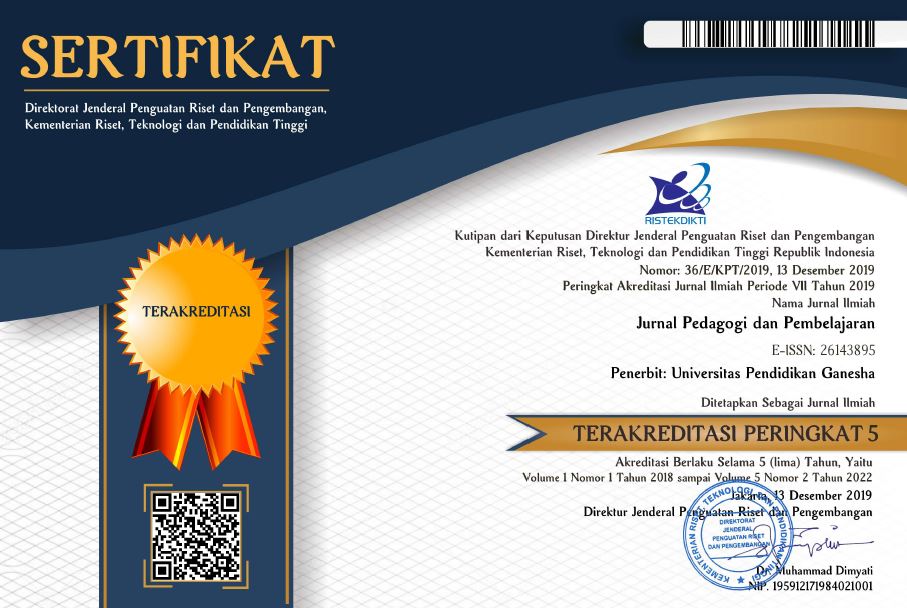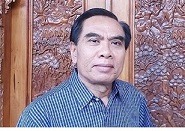Teaching Style, Digital Literacy, and Self-Efficacy on Early Childhood Education Teacher Capabilities
DOI:
https://doi.org/10.23887/jp2.v7i1.75851Keywords:
preschool teacher capability, self-efficacy, teaching style, digital literacyAbstract
Problems experienced by PAUD teachers during online learning are viewed from educational background, length of teaching and self-efficacy. The purpose of the study was to analyze the relationship between digital literacy (LD), teaching style (GM) and self-efficacy (ED) on the capabilities of PAUD teachers (KG) during the Covid 19 pandemic. This research is quantitative using the expost facto model to determine the causal relationship between events and conditions. The sample used proportional stratified random sampling of 355 teacher respondents with more than three years of teaching experience and a diverse educational background. The instrument used was a questionnaire with descriptive statistical analysis techniques and Structural Equation Modelling (SEM). We collected data through digital literacy questionnaire, teaching style scale, self-efficacy instrument and ECD teachers' capabilities. The study found that: 1) there is a relationship between LD and GM; 2) there is no relationship between LD and ECD KG; 3) there is a relationship between LD and ECD teachers' ED; 4) there is a relationship between GM and teachers' ED; 5) there is a relationship between GM and KG; 6) there is a relationship between ED and KG; 7) there is a relationship between LD and KG through ED; 8) there is no relationship between GM and KG through ED.
References
Al Mamun, M. A., Lawrie, G., & Wright, T. (2022). Exploration of learner-content interactions and learning approaches: The role of guided inquiry in the self-directed online environments. Computers & Education, 178, 104398. https://doi.org/10.1016/j.compedu.2021.104398. DOI: https://doi.org/10.1016/j.compedu.2021.104398
Anhusadar, L. O. (2016). Kreativitas Pendidikan Di Lembaga PAUD. Jurnal Al-Ta’dib, 9(1), 76–93. https://ejournal.iainkendari.ac.id/al-tadib/article/view/503.
Aslam, F., Adefila, A., & Bagiya, Y. (2018). STEM outreach activities: an approach to teachers’professional development. Journal of Education for Teaching, 44(1), 58–70. https://doi.org/10.1080/02607476.2018.1422618. DOI: https://doi.org/10.1080/02607476.2018.1422618
Aslan, S. (2021). Analysis of digital literacy self-efficacy levels of pre-service teachers. International Journal of Technology in Education (IJTE), 4(1), 57–67. https://eric.ed.gov/?id=EJ1286441. DOI: https://doi.org/10.46328/ijte.47
Asrizal, Amran, A., Ananda, A., Festiyed, F., & Sumarmin, R. (2018). The development of integrated science instructional materials to improve students’ digital literacy in scientific approach. Jurnal Pendidikan IPA Indonesia, 7(4), 442–450. https://doi.org/10.15294/jpii.v7i4.13613. DOI: https://doi.org/10.15294/jpii.v7i4.13613
Bandura, A. (1977). Self-efficacy: The exercise of control. Freeman.
Basyoni, A., Bee, M., S., H., Seng, G., & H. (2020). The effectiveness of using students’ created digital storytelling in enhancing Saudi ninth graders’ critical listening skills. Journal of Education and Social Sciences, 16(1), 58–72. https://doi.org/https://www.jesoc.com/wp-content/uploads/2020/12/JESOC16-030.pdf.
Brady, A. C., Kim, Y. E., & Cutshall, J. (2021). The what, why, and how of distractions from a self-regulated learning perspective. Journal of College Reading and Learning, 51(2), 153–172. https://doi.org/10.1080/10790195.2020.1867671. DOI: https://doi.org/10.1080/10790195.2020.1867671
Bystrova, T. (2020). Infographics As a Tool for Improving Effectiveness of Education. KnE Social Sciences, 2020, 152–158. https://doi.org/10.18502/kss.v4i13.7710. DOI: https://doi.org/10.18502/kss.v4i13.7710
Cubukcu, C., Murat, K. C., & Yigit, O. (2020). “Mobile Game Development for Children with Down Syndrome.” International Journal of Interactive Mobile Technologies, 14(20), 174–83,. https://doi.org/10.3991/IJIM.V14I20.16573. DOI: https://doi.org/10.3991/ijim.v14i20.16573
Danuri, & Maisaroh, S. (2019). Metodologi Penelitian Pendidikan. Yogyakarta: Samudra Biru (Anggota IKAPI).
Daud, A. (2020). Strategi Guru Mengajar Di Era Milenial. Al-Mutharahah: Jurnal Penelitian Dan Kajian Sosial Keagamaan, 17(1), 29–42. https://doi.org/10.46781/al-mutharahah.v17i1.72. DOI: https://doi.org/10.46781/al-mutharahah.v17i1.72
Ellizah, D. L., Fadlaini, M., Aerin, W., Istiningsih, I., & Rokhimawan, A. (2020). Planning of PAUD Learning with STEAM (Science, Technology, Art, and Math) Approach. Indonesian Journal of Early Childhood Education Studies, 9(2), 67–72. https://doi.org/10.15294/ijeces.v9i2.39359.
Falloon, G. (2020). From digital literacy to digital competence: the teacher digital competency (TDC) framework. Educational Technology Research and Development, 68(5), 2449–2472. https://doi.org/10.1007/s11423-020-09767-4. DOI: https://doi.org/10.1007/s11423-020-09767-4
Gilakjani, A. P. (2012). A Match or Mismatch Between Learning Styles of the Learners and Teaching Styles of the teachers. Modern Education and Computer Science, 11, 51–60. https://doi.org/10.5815/ijmecs.2012.11.05. DOI: https://doi.org/10.5815/ijmecs.2012.11.05
Hair, J., & Alamer, A. (2022). Partial Least Squares Structural Equation Modeling (PLS-SEM) in second language and education research: Guidelines using an applied example. Research Methods in Applied Linguistics, 1(3), 100027. https://doi.org/10.1016/j.rmal.2022.100027. DOI: https://doi.org/10.1016/j.rmal.2022.100027
Han, F., & Ellis. (2019). RA Identifying consistent patterns of quality learning discussions in blended learning. The Internet and Higher Education, 40, 12–19,. https://doi.org/10.1016/j.iheduc.2018.09.002. DOI: https://doi.org/10.1016/j.iheduc.2018.09.002
Hardiyana, A. (2016). Optimalisasi Pemanfaatan Teknologi Informasi dan Komunikasi dalam Pembelajaran PAUD. AWLADY: Jurnal Pendidikan Anak, 2(1), 1–12. https://doi.org/10.24235/awlady.v2i1.
Jamal, S. (2020). Analisis Kesiapan Pembelajaran E-Learning Saat Pandemi Covid-19 Di Smk Negeri 1 Tambelangan. Jurnal Nalar Pendidikan, 8(1), 16. https://doi.org/10.26858/jnp.v8i1.13561. DOI: https://doi.org/10.26858/jnp.v8i1.13561
Jelatu, S., Yohanes, K., Valeria, S. K., Kanisius, M., & Ricardus, J. (2019). “Collaboration TPS Learning Model and M-Learning Based on Android for Understanding of Trigonometry Concepts with Different Cognitive Style.” International Journal of Instruction, 12(4), 545–60,. https://doi.org/10.29333/iji.2019.12435a. DOI: https://doi.org/10.29333/iji.2019.12435a
Lampropoulos, G., Siakas, K., & Anastasiadis, T. (2019). Internet of Things in the Context of Industry 4.0: An Overview. International Journal of Entrepreneurial Knowledge, 7(1), 4–19. https://doi.org/10.2478/ijek-2019-0001. DOI: https://doi.org/10.2478/ijek-2019-0001
Machmud, H., & Alim, N. (2018). Multicultural Learning Model of PAUD in Coastal Areas. Jurnal Obsesi : Jurnal Pendidikan Anak Usia Dini, 2(2), 170. https://doi.org/10.31004/obsesi.v2i2.74. DOI: https://doi.org/10.31004/obsesi.v2i2.74
Mulholland, J., & Wallace, J. (2001). Teacher induction and elementary science teaching: Enhancing self-efficacy. Teaching and Teacher Education, 17(2), 243–261. https://doi.org/10.1016/S0742-051X(00)00054-8. DOI: https://doi.org/10.1016/S0742-051X(00)00054-8
Müller, F. A., & Wulf, T. (2020). Technology-supported management education: a systematic review of antecedents of learning effectiveness. International Journal of Educational Technology in Higher Education, 17(1). https://doi.org/10.1186/s41239-020-00226-x. DOI: https://doi.org/10.1186/s41239-020-00226-x
Nieto-Escamez, F. A., & Roldán-Tapia, M. D. (2021). Gamification as Online Teaching Strategy During COVID-19: A Mini-Review. Frontiers in Psychology, 12(May), 1–9. https://doi.org/10.3389/fpsyg.2021.648552. DOI: https://doi.org/10.3389/fpsyg.2021.648552
Parvathamma, N., & Pattar, D. (2013). Digital literacy among student community in management institutes in Davanagere District, Karnataka State, India. Annals of Library and Information Studies (ALIS), 60(3), 159–166. https://doi.org/10.56042/alis.v60i3.863.
Putri Ningrat, S., Tegeh, I. M., & Sumantri, M. (2018). Kontribusi Gaya Belajar Dan Motivasi Belajar Terhadap Hasil Belajar Bahasa Indonesia. Jurnal Ilmiah Sekolah Dasar, 2(3), 257. https://doi.org/10.23887/jisd.v2i3.16140. DOI: https://doi.org/10.23887/jisd.v2i3.16140
Rohmah, F. N., & Bukhori, I. (2020). Pengembangan Media Pembelajaran Interaktif Mata Pelajaran Korespondensi Berbasis Android Menggunakan Articulate Storyline 3. ECOEDUCATION (Economic & Education Journal), 2(2), 169–182. https://doi.org/10.33503/ecoducation.v2i2.892. DOI: https://doi.org/10.33503/ecoducation.v2i2.892
Sari, N. F. (2017). Perbandingan Hasil Belajar Siswa yang Diajar Menggunakan Model Pembelajaran Quantum Teaching dengan Model Pembelajaran Langsung (Direct Instruction) Pada Sub Bab Materi Pokok Sistem Respirasi Pada Manusia di Kelas XI SMA Swasta Medan Putri Tahun Pembelaja. Edu Science, 4(2), 18–24. https://doi.org/10.36987/jes.v4i2.935.
Schunk, D. H., & DiBenedetto, M. K. (2020). Motivation and social cognitive theory. Contemporary Educational Psychology, 60, 101832. https://doi.org/10.4103/0019-5154.182410. DOI: https://doi.org/10.1016/j.cedpsych.2019.101832
Suhendro, E. (2020). Strategi Pembelajaran Pendidikan Anak Usia Dini di Masa Pandemi Covid-19. Golden Age: Jurnal Ilmiah Tumbuh Kembang Anak Usia Dini, 5(3), 133–140. https://doi.org/10.14421/jga.2020.53-05. DOI: https://doi.org/10.14421/jga.2020.53-05
Sulianta, F., Sapriya, S., Supriatna, N., & Disman, D. (2019). Digital Content Model Framework Based on Social Studies Education. International Journal of Higher Education, 8(5), 3–11. https://doi.org/10.5430/ijhe.v8n5p214. DOI: https://doi.org/10.5430/ijhe.v8n5p214
Ujianti, P. R., Suastika, N., & Dewi, P. S. D. (2021). Tantangan Praktek Pembelajaran Anak Usia Dini di Masa Pandemi Covid-19. Jurnal Pendidikan Anak Usia Dini Undiksha, 9(3), 318. https://doi.org/10.23887/paud.v9i3.41841. DOI: https://doi.org/10.23887/paud.v9i3.41841
Van, N. T., A., A. F., A., H., Fareed, A., & Daniel, D. (2021). “Digital Readiness for Social Educators in Health Care and Online Learning During the COVID-19 Pandemic: A Bibliometric Analysis.” International Journal of Interactive Mobile Technologies, 15(18), 104–15,. https://doi.org/10.3991/ijim.v15i18.25529. DOI: https://doi.org/10.3991/ijim.v15i18.25529
Winarno, A., Fedin, M. Y. A., & Salleh, N. H. M. (2022). the Effect of Technological Literacy, Learning Facility, and Family Environment on Students’ Learning Motivation. Jurnal Pendidikan: Teori, Penelitian, Dan Pengembangan, 7(7), 246. https://doi.org/10.17977/jptpp.v7i7.15404. DOI: https://doi.org/10.17977/jptpp.v7i7.15404
Downloads
Published
How to Cite
Issue
Section
License
Copyright (c) 2024 sya'dullah achmad

This work is licensed under a Creative Commons Attribution-ShareAlike 4.0 International License.
Authors who publish with Jurnal Pedagogi dan Pembelajaran agree to the following terms:- Authors retain copyright and grant the journal the right of first publication with the work simultaneously licensed under a Creative Commons Attribution License (CC BY-SA 4.0) that allows others to share the work with an acknowledgment of the work's authorship and initial publication in this journal
- Authors are able to enter into separate, additional contractual arrangements for the non-exclusive distribution of the journal's published version of the work (e.g., post it to an institutional repository or publish it in a book), with an acknowledgment of its initial publication in this journal.
- Authors are permitted and encouraged to post their work online (e.g., in institutional repositories or on their website) prior to and during the submission process, as it can lead to productive exchanges, as well as earlier and greater citation of published work. (See The Effect of Open Access)













